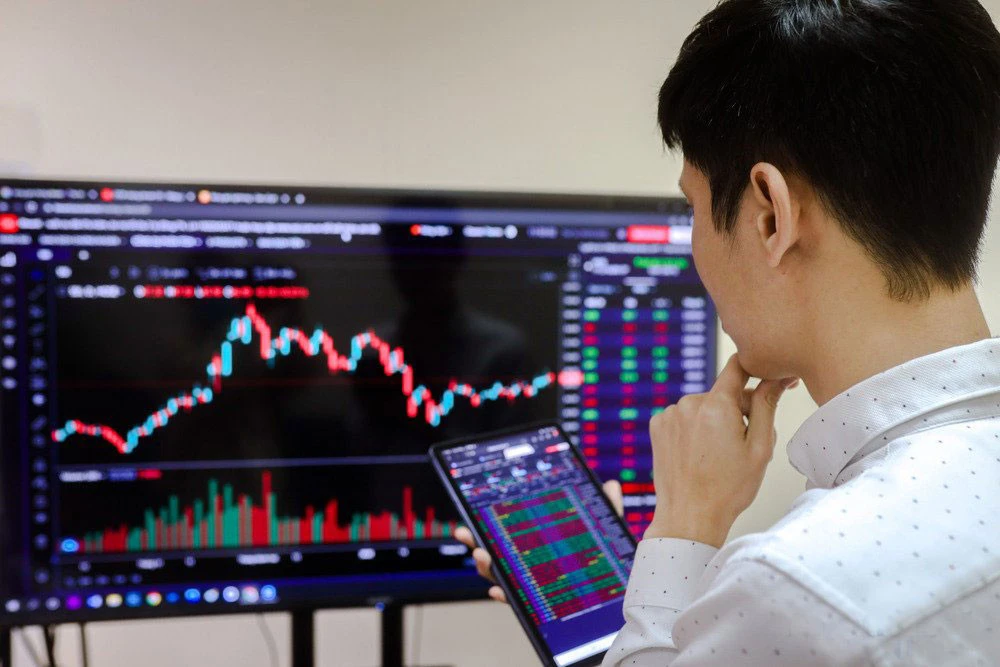
Since the beginning of September 2023, HoSE has observed a net capital withdrawal exceeding VND 14,000 billion. Despite the foreign sell-off, the market demonstrated resilience, indicating a strengthening of capital flows from domestic investors, particularly individual investors.
Exceptional Domestic Cash Flow
Within the total daily trading value, various investor groups contribute to market dynamics. The four primary capital flows include domestic individual investors, domestic institutional investors, foreign investors, and the self-trading sectors of securities companies. These cash flows operate with differing intensities and market perspectives. Foreign investors' net selling constitutes only a fraction, with the average buying proportion accounting for approximately 7%, and the selling proportion making up nearly 7.6% of daily transactions from the beginning of September 2023 to the present. This shift signifies a departure from foreign investors dominating the capital flow.
To withdraw capital from stocks, foreign investors must successfully sell, implying that for every net selling capital from this group, there must be a corresponding capital inflow from other sources. Therefore, the substantial net selling figure of foreign investors also represents, on one hand, the capital inflow of domestic investors to replace it.
According to FiinTrade data from the beginning of 2023 until now, both foreign investors and domestic organizations have been net withdrawers from the market. Specifically, on HoSE alone, foreign investors withdrew a net amount of VND 13,352 billion, while domestic investment organizations (domestic legal entity accounts) withdrew a net amount of about VND 8,416 billion. Conversely, net buying investors include domestic individual investors with about VND 17,471 billion and proprietary trading of securities companies with VND 5,038 billion.
Personal cash flow stands out due to its large accumulation scale, although it is not a continuous net purchase. This group of investors exited the market during the first five months of 2023 and only started to return to a net accumulation position from the beginning of June (see chart). When associated with macroeconomic events, the cumulative net buying by individual investors aligns with the time when the State Bank of Vietnam lowered interest rates for the third time, with the first cut occurring in mid-March 2023. Notably, from August 2023 onwards, domestic personal cash flow accumulating stocks has been robust, coinciding with the trend of rapidly decreasing deposit interest rates of commercial banks and the savings maturity cycle.
While some perceive savings interest rates to be "at the bottom," the net accumulation figure in the market indicates a significant amount of money has been invested in buying and holding stocks. Daily liquidity may not be surging, but this does not imply a lack of capital flow movement. Daily transactions on the stock market involve short-term exchanges that contribute to liquidity. If the demand for holding stocks surpasses the need for short-term trading, transaction sizes may remain average. Reality also demonstrates that during continuous market declines or upswings, daily liquidity is high due to increased transaction demand.
Long-Term Investment Opportunities in a Shifting Market Landscape
The market presents favorable conditions for long-term investment, as reflected in monthly data releases from the State Bank on resident deposit growth. Despite a considerable drop in savings interest rates, the trend of depositing money in banks continues to rise. In the latest data available as of September 2023, individuals deposited nearly VND 6,450,000 billion, marking a 9.95% increase compared to the end of 2022. This follows a similar pattern in September 2022 when the corresponding figure reached nearly VND 5,640,000 billion, indicating a 6.38% increase compared to the end of 2021. However, details about the term of these deposits remain undisclosed.
Amidst the landscape of very low interest rates, deposits have not emerged as a competitive channel against stocks. For those with investment experience or a willingness to take risks, leaving money in savings is deemed an ineffective solution. The almost absolute safety provided by the savings channel comes at the cost of a modest profit (interest rate) of approximately 5-6% per year. Opting for alternative channels like stocks involves higher risks. However, investors who choose to focus on long-term bets on the future of businesses and the growth of the national economy may encounter different risks.
The long-term cycle of the stock market is intricately linked to the macroeconomic and business cycles of enterprises. The riskiest periods in the stock market are often closely tied to macroeconomic events. For instance, the sharp market decline in 2022 was associated with the domestic corporate bond bubble and the global trend of monetary tightening to curb inflation. By 2023, macro risks have significantly diminished and are poised to potentially reverse, given the conclusion of the interest rate hike cycle.
In conclusion, the current market environment, marked by increasing bank deposits despite low interest rates, suggests that long-term investment strategies focusing on the future of businesses and the national economy may present unique opportunities. With macro risks on the decline and the potential for a reversal in the interest rate hike cycle, investors willing to embrace a long-term perspective could find the market conducive to their objectives.




















